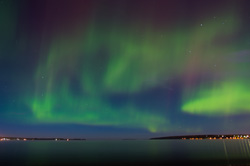The Science Behind Those Eye-Popping Northern Lights

Sarah Bird/Michigan Technological University<br> <br>Aurora borealis above Keweenaw Bay, near Baraga, Michigan, on Sept. 30, 2012.<br>
An aurora borealis (aurora australis in the Southern Hemisphere) is precipitated by explosions on the surface of the sun, sometimes starting as solar flares, said Robert Nemiroff, an astrophysicist at Michigan Technological University and coauthor of NASA’s Astronomy Picture of the Day website.
These flares release a burst of charged particles, or plasma, into the solar system. When they come our way, they whack into the Earth’s magnetosphere, which is made up of its own stream of charged particles. That collision causes particles to break free of the magnetosphere and cascade toward the Earth’s magnetic field lines, usually traveling toward the poles.
“The aurorae happen when these high-energy particles bap into atoms and molecules in the Earth’s atmosphere, typically oxygen,” Nemiroff said. Light is emitted as part of the reaction.
Those particles can also wreak havoc. “The plasma cloud can cause the Earth’s magnetic field to fluctuate,” Nemiroff said. “At worst, that can knock out satellites and even power grids.”
Aurorae can happen anytime, but it’s no surprise they are happening now.
“We are nearing the solar maximum, which is when the sun is at its most active,” he said. Solar maximums come around every 11 years, but no one knows why.
“You can have solar flares and aurorae during the solar minimum, but we get more now because the sun’s magnetic field is tangled up and poking through the surface, releasing plasma,” said Nemiroff.
Robert Nemiroff, nemiroff@mtu.edu, 906-487-2198
Marcia Goodrich, mtunews@mtu.edu, 906-487-2343
Media Contact
More Information:
http://www.mtu.eduAll latest news from the category: Physics and Astronomy
This area deals with the fundamental laws and building blocks of nature and how they interact, the properties and the behavior of matter, and research into space and time and their structures.
innovations-report provides in-depth reports and articles on subjects such as astrophysics, laser technologies, nuclear, quantum, particle and solid-state physics, nanotechnologies, planetary research and findings (Mars, Venus) and developments related to the Hubble Telescope.
Newest articles

Bringing bio-inspired robots to life
Nebraska researcher Eric Markvicka gets NSF CAREER Award to pursue manufacture of novel materials for soft robotics and stretchable electronics. Engineers are increasingly eager to develop robots that mimic the…

Bella moths use poison to attract mates
Scientists are closer to finding out how. Pyrrolizidine alkaloids are as bitter and toxic as they are hard to pronounce. They’re produced by several different types of plants and are…

AI tool creates ‘synthetic’ images of cells
…for enhanced microscopy analysis. Observing individual cells through microscopes can reveal a range of important cell biological phenomena that frequently play a role in human diseases, but the process of…





















